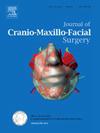双侧唇腭裂患者行上颌骨前截骨联合二次牙槽骨移植的三维虚拟手术计划:回顾性准确性分析。
IF 2.1
2区 医学
Q2 DENTISTRY, ORAL SURGERY & MEDICINE
引用次数: 0
摘要
本回顾性研究评估了三维虚拟规划和计算机辅助设计/计算机辅助制造夹板在上颌前截骨联合二次牙槽骨移植中的手术准确性。该研究包括2016年至2023年期间由荷兰cleft Team North治疗的所有连续双侧唇腭裂患者,他们接受了上颌前截骨和二次牙槽骨移植。三维虚拟手术计划是基于锥形束计算机断层扫描和口内扫描或石膏模型。通过三次线性和三次角度测量,比较计划和术后的上颌骨图像来评估手术的准确性。纳入11例患者(平均年龄:9.8岁)。计划结果与术后结果之间的平均欧氏距离为1.57±0.79 mm。线性测量显示,中外侧平均差异为0.74±0.76 mm,颅尾0.65±0.53 mm,前后0.89±0.70 mm。俯仰角差为6.66±5.12°,偏航角差为5.09±5.14°,横摇角差为4.61±5.05°。观察者内变异率为0.85±0.58 mm,类内相关系数为0.99。采用三维虚拟手术计划和计算机辅助设计/计算机辅助制造夹板在上颌前截骨联合二次牙槽骨移植中可达到较高的手术精度。本文章由计算机程序翻译,如有差异,请以英文原文为准。
3D virtual surgical planning in patients with bilateral cleft lip and palate undergoing premaxilla osteotomy combined with secondary alveolar bone grafting: a retrospective accuracy analysis
This retrospective study evaluates the surgical accuracy of 3D virtual planning and the use of computer-aided design/computer-aided manufacturing splints in premaxillary osteotomy combined with secondary alveolar bone grafting.
The study included all consecutive patients with bilateral cleft lip and palate undergoing a premaxillary osteotomy with secondary alveolar bone grafting treated by the Cleft Team North (the Netherlands) between 2016 and 2023. 3D virtual surgical planning was based on cone beam computed tomography scans and intraoral scans or plaster models. Surgical accuracy was assessed by comparing the planned and postoperative images of the premaxilla through three linear and three angular measurements. Eleven patients were included (mean age: 9.8 years). The mean Euclidean distance between the planned and postoperative outcomes was 1.57 ± 0.79 mm. Linear measurements showed mean differences of 0.74 ± 0.76 mm medio-laterally, 0.65 ± 0.53 mm caudo-cranially, and 0.89 ± 0.70 mm anteroposteriorly. Angular differences were 6.66 ± 5.12° for pitch, 5.09 ± 5.14° for yaw, and 4.61 ± 5.05° for roll. The intra-observer variability was 0.85 ± 0.58 mm and the intraclass correlation coefficient 0.99.
High surgical accuracy can be achieved using 3D virtual surgical planning and computer-aided design/computer-aided manufacturing splints in premaxillary osteotomy combined with secondary alveolar bone grafting.
求助全文
通过发布文献求助,成功后即可免费获取论文全文。
去求助
来源期刊
CiteScore
5.20
自引率
22.60%
发文量
117
审稿时长
70 days
期刊介绍:
The Journal of Cranio-Maxillofacial Surgery publishes articles covering all aspects of surgery of the head, face and jaw. Specific topics covered recently have included:
• Distraction osteogenesis
• Synthetic bone substitutes
• Fibroblast growth factors
• Fetal wound healing
• Skull base surgery
• Computer-assisted surgery
• Vascularized bone grafts

 求助内容:
求助内容: 应助结果提醒方式:
应助结果提醒方式:


